Oman
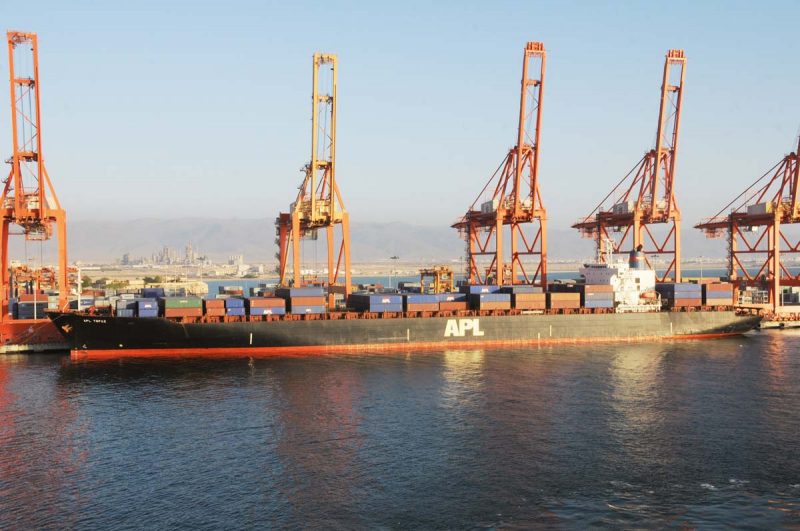
The Port of Salalah is the largest port in Oman and is situated in the Dhofar region near the border with Yemen in the northern part of the Indian Ocean. It is located at the crossroads of trade between Europe and Asia and has a very large transhipment trade of over 5.0 million TEU of containers per annum, and an annual general cargo throughput of 13.5 million tonnes, with forty international cruise ships calling and over 600,000 tourists per annum. The port serves the markets of East Africa, the Red Sea, the Indian subcontinent and of container ships heading for the Persian Gulf, which can offload their containers for onward shipment to the Far East for example.
The port has only been open for twenty years, coming into operation in 1998 for APM Terminals, the terminal subsidiary of Maersk Line, by far the biggest container line in the world with at least three large Maersk Line container ships to be seen in the port every day. The landmark agreement was signed in 1996 between Maersk Line, Sealand and the Government of Oman to provide a modern transhipment hub terminal at Salalah, and was the first Governmental and private partnership in the history of Oman. The operating company of Salalah Port Services Company (S.A.O.G.) is listed on the Omani stock exchange. The port consists of a very large container terminal with 25 red painted Super Post Panamax Gantry Cranes pointing in an easterly direction opposite a long easterly breakwater with a general cargo terminal at its western end, an open quay for cruise ships, and a concrete apron area for Arab owned coasters, and Royal Oman Navy coastal patrol vessels.
The port has a neighbouring port known as Mina Raysut, developed in three stages from 1971 to accommodate vessels up to a draft of four metres, but today the Port of Salalah can accommodate vessels up to a draft of eighteen metres, and is the main container transhipment port of the entire Oman region. The Port of Mina Raysut handled basic foodstuffs, livestock, farming tools, and raw materials. The former London and Rochester Trading Co. Ltd. three hold coaster Resurence of 552 grt and built in Italy in 1958 by Cantieri Naviera Pellegrino of Naples as Singorita was purchased by the Sultanate of Oman in 1971 and renamed Dhofar for operation from Mina Raysut. She was expended on 18th May 1980 as a target for an Exocet missile test off Oman.
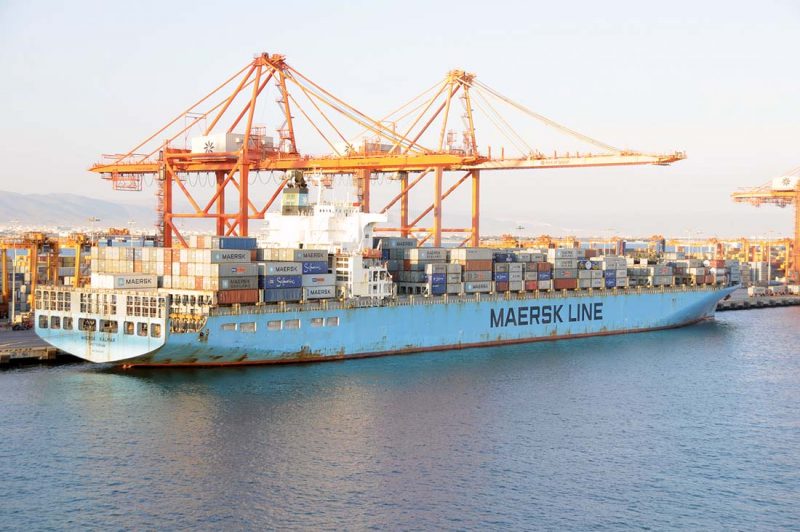
Oman has a buoyant economy with decades of oil and gas revenues and a diversification strategy aimed at developing the new ports of Salalah, Sohar and Duqm to reduce its dependence on oil and gas. Salalah has played an important role in trade due to its strategic location for many centuries. The trade route activity from Salalah can be traced back to the ports of Khor Rori (Sumhuram) and Al Balid, which for over seven hundred years were meeting points connecting trade across the Roman, Egyptian, Indian, Persian and African empires from the sixth century BC to the second century AD. This history goes back to the days when Salalah was an important trading port for frankincense and silk.
History Of Salalah And Oman
In the sixth century BC, the Persians attacked this region and made incursions to control parts of the Persian Gulf and most of neighbouring Oman for a period of time. However, they ignored the extremely hot desert of the southern third of what today is Saudi Arabia and is called the Rub’ al Khali or the ‘Empty Quarter’, where average daily temperatures reach almost fifty degrees Centigrade. This is the largest contiguous sand desert in the world, encompassing an area covering 251,000 square miles, a peak temperature of 51 degrees Centigrade was recorded here recently, way beyond the normal operating temperature for most of mankind, with only the few roaming Bedouin tribes having the knowledge of how to cross this trackless area with their camel trains.
The Islam religion of the prophet Mohammed was embraced in the year 630 when Omanis sent emissaries to Muslims in the Western Arabian city of Medina. Islam then became the religion of all Omanis and other Arabs that today form part of the United Arab Emigrates (UAE). The Western powers of Europe and the United States of America had little idea of what lay in what is now Oman, Saudi Arabia and the UAE. The discovery of oil in the lands of the northern part of the Persian Gulf changed that area to a huge extent, but the southern lands remained an enigma, shrouded in mystery. The adventurer Wilfred Thesiger crossed the Rub’ al Khali in 1948 with the help of the native Bedouin tribes, but the fabled lost city of Ubar in a remote area of Oman was only discovered as recently as 1992.
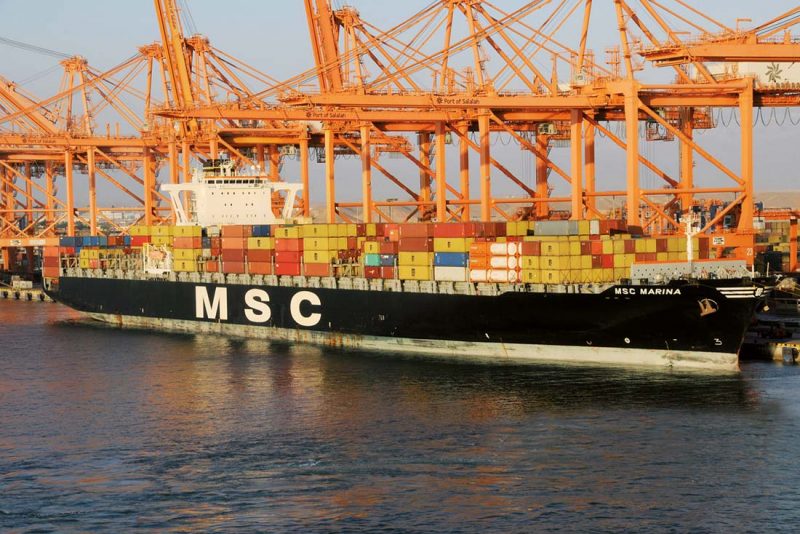
The British arrived in the area shortly after 1800 with Dubai being no more than a fortified town, surviving despite frequent pirate attacks. The first set of peace treaties between the Arabs and Britain was in 1820 in the sheikdom that was called the ‘Trucial Oman’ and is now part of the UAE. The small number of these sheikdoms could be counted on the fingers of two hands, who owed their allegiances to either the Sultan in Muscat, the capital of Oman, or the Sheikh in Abu Dhabi. In 1891, Britain established a special relationship with Oman by Treaty. Since then, Britain has intervened in the traditional quarrels of the Ibadi Muslims with the Sunni Muslim minority, and in the rivalries between the main tribes. The British deposed the last Ibadi Imam leader in 1958. The present Sultan Qaboos of Oman has his palace in Muscat, but he also makes occasional visits to Salalah, the Omani city of the southern Dhofar part of the country.
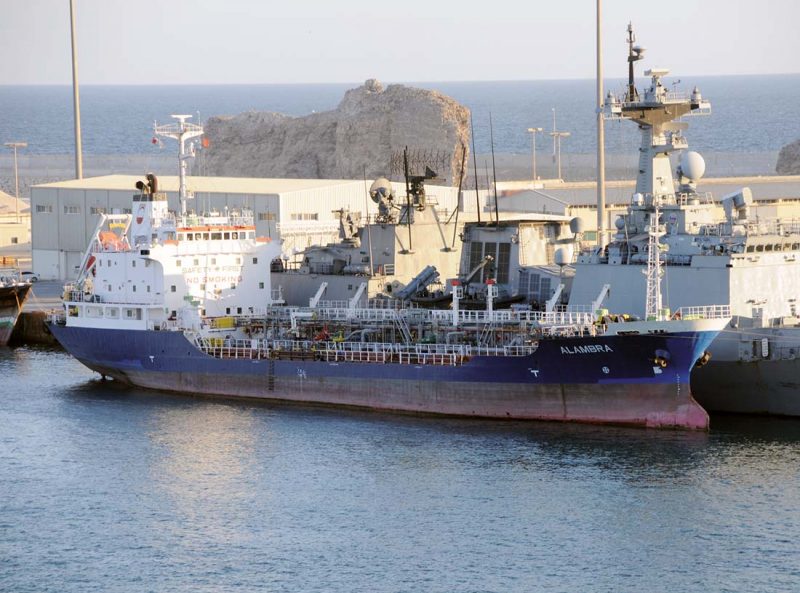
Salalah reached a peak of prosperity in the thirteenth century thanks to the incense trade with large numbers of frankincense trees grown along the southern coast. Salalah was absorbed by the Sultanate of Muscat in the nineteenth century, and became its capital between 1932 and 1970 under the royal family of Sultan bin Taimur, the royal family that had ruled Oman from antiquity. An assassination attempt was made in 1966 on Sultan bin Taimur, and Sultan Qaboos, his son, decided to move the capital of Oman to Muscat after the death of his father on 23rd July 1970. The Sultan would normally live in the Grand Palace of Salalah rather than in Muscat, but Sultan Qaboos has lived in Muscat since he ascended to the throne in 1970, but he visits Salalah occasionally around once every four years. A large parade was held in Salalah in 2010 to mark the fortieth year of the ascendancy of Sultan Qaboos to the throne and his visit to the city. However, protests began to surface a year later in 2011 with the ‘Arab Spring Movement’ with the expulsion of ministers, a revolt against the increased cost of living, and the establishment of many new Islamic Banks.
Salalah is fifty miles from the southern extremity of the Rub’ al Khali with the Jabal al Qara mountains of over 3,000 feet in height rolling down to the sea and tending to keep Salalah cooler, especially during the two months of July and August and the strong monsoon winds, although generally only a little rain falls. Salalah is the ‘perfume capital’ of Arabia due to the large number of frankincense trees along this stretch of the coast. Salalah in fact means the ‘shining one’ in the local Jabali language.
Political unrest in Oman dates back to 1961 when the British India Line passenger ship Dara had bombs planted inside her by Omani rebels. The ship was on a voyage from Basrah to Bombay with eight hundred passengers and crew onboard. The bomb blasts occurred while the ship was off Dubai and killed 236 passengers and crew, with Dara sinking two days later. Oman became an independent country in 1971, but a year later an armed rebellion took place in Oman with communist sympathies and left wing rebels tried to overthrow the royal family of the Sultan. British R.A.F. ‘V’ bombers and ‘Lightning’ fighter aircraft were called in to target the hidden desert bases of the rebels, and finally the insurrections ceased in 1976. Bomb atrocities in the region have continued after the Millennium along the coastline from Yemen to Salalah when a large hole was blown in the port quarter of the U.S. destroyer Cole by a bomb onboard a fast powerboat. A mastermind rebel associated with the ‘Al Qaida’ regime in the mountains bordering Pakistan and Afghanistan had ordered the attack from his base in the deserts of Oman. This rebel commander was arrested in October 2002 and convicted of several atrocities and handed over to the CIA in Washington and then securely locked up for life in Guantanamo Bay in Cuba.
Dhofar is the largest of the eleven Governorates of the Sultanate of Oman covering 38,300 square miles with a population of only 249,700. Salalah is the largest city, which in antiquity was once a well cultivated area with a sophisticated irrigation system. A counter insurgency, the Omani Civil War (1963-1976), was fought here by the Sultan’s Armed Forces against guerrilla fighters of the nationalist Dhofar Liberation Force with Marxist and Communist sympathies. The campaign was backed by U.K. Armed Forces and was declared over in December 1975 when the guerrilla forces surrendered.
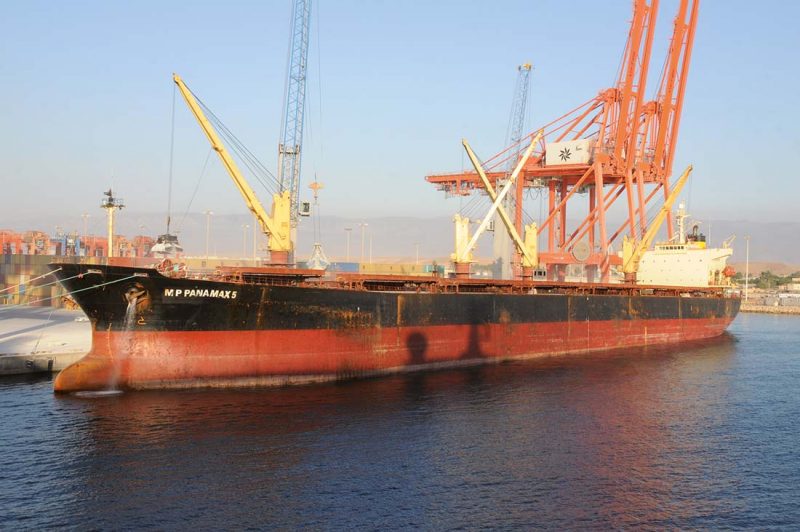
The Arab word of ‘khareef’ means autumn in Arabic but generally refers to the monsoon season, when the brown arid scenery of Salalah briefly blossoms and is transformed to green vegetation to give a verdant appearance during the two months of the monsoon. The Port of Salalah was closed for a number of days after the strong monsoon winds struck the port on 25th May 2018. Cyclone Mekunu caused extensive damage to the port, with the 25 large Post Panamax Gantry Cranes securely tied down ahead of the arrival of the storm. All Maersk Line and other container ships and general cargo ships had been ordered out of the port to sea. It took six days to sweep up the mess left behind by the storm as the port had been left without power and all communication systems including the Internet, which had been closed down. The Government of Oman declared a three day holiday for all port employees and those in associated businesses to allow time to assess the high level of damage to the port. Maersk Line established a website for container customers to keep them informed when container ships would be allowed to enter the port again, with the first ship arriving in June 2018.
Port Of Salalah
The Port of Salalah is the eleventh largest container transhipment port in the world and is located at position 16°57′ N, 54°01′ East. It is owned as a joint venture by the Government of Oman, and APM Terminals and other Omani investors. It has been operating since November 1998 and is recognised globally as an important transhipment port hub, and continues to play a vital role in the economic future of the Sultanate of Oman. The port lies on the Europe to Far East shipping lane, and is a useful port for shipping lines and shippers in order to access the Middle East, Persian Gulf, East Africa and the Indian subcontinent.
The Port of Salalah set a world record for productivity with 250 container moves per hour in 1999, and won the Best Investment Project in Oman award. The General Cargo Terminal came under the Port of Salalah management in 2000, and bunkering facilities were completed. The volumes handled by the Container Terminal exceeded its design capacity for the first time in 2002. An expansion project for two new berths was approved in 2003 as well as for a new breakwater. The port was the winner of the Best Middle East Seaport at the Asian Freight and Supply Chain awards. The landmark of having handled ten million TEU of containers since opening was achieved in 2005, and a fully equipped Training Centre was under construction. The port received six additional Post Panamax Gantry Cranes in 2006,, with Berth 5 completed a year later. Container volumes handled per annum were now 2.5 million TEU, and general cargo volumes exceeded 2.8 million tonnes per annum.
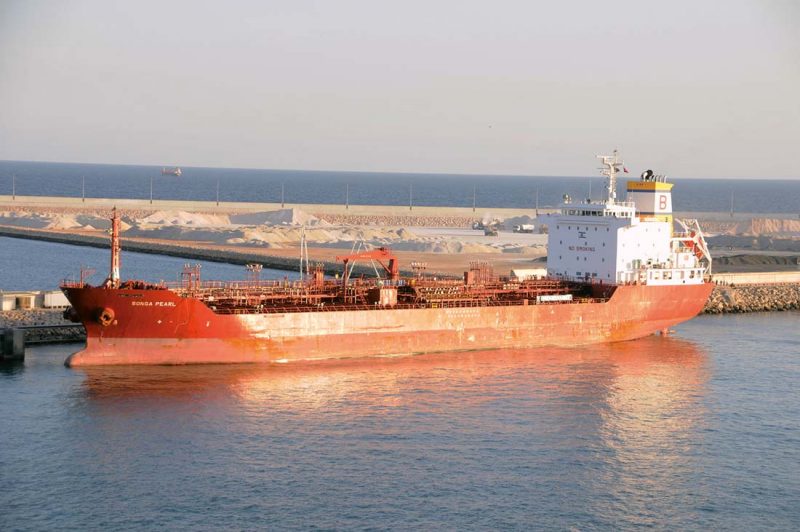
Berth 6 was completed in 2008, with the total of twenty million TEU handled since 1998 celebrated in 2009. The port received four additional Post Panamax Gantry Cranes and six Rubber Tyre Gantry Cranes in 2009, with also a commitment to reduce carbon emissions by 25% within five years. The General Cargo Terminal received new bulk handling equipment in 2011 and also won the Lloyd’s List Safety Award. An expansion to handle twenty million tonnes of dry bulk commodities and over six million tonnes of liquid products was begun in 2012, with a total of thirty million TEU of containers handled since opening. The port won the Most Improved Terminal in the Asia Middle East (AME) region in 2012, as well as awards for Corporate Social Responsibility in Containerisation and in Omani Green Awards.
American President Lines (APL) began calling at the port in 2003, and to mark the tenth anniversary the Governor of Dhofar paid a visit onboard one of the largest container ships in the world, APL Salalah. An expansion of the General Cargo Terminal began in 2014 to triple the port capacity and provide new storage for liquid bulk, and an expansion at the Container Terminal in order to add a further three million TEU of containers capacity. This new deep water General Cargo Terminal and Liquid Bulk Terminal became operational in 2015 to provide twenty million tonnes of dry bulk and six million tonnes of liquid bulk capacity. A total of 24 Moormaster buoys were laid at the port during 2016 and 2017 to effectively hold large capacity ships during the Khareef (monsoon) period. A new dual lane road to the Port of Salalah was completed in 2017 with a length of just over 2.7 kilometres and designed with three roundabouts.
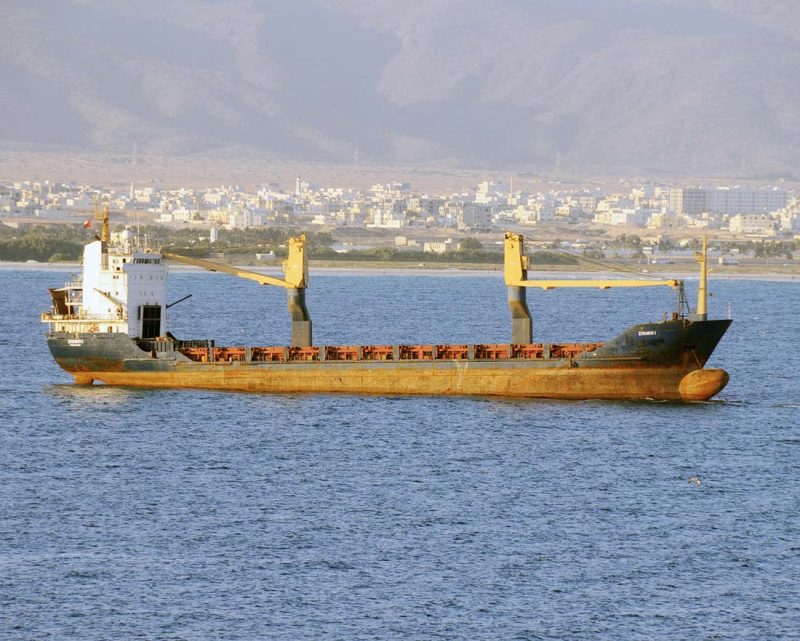
The port in 2019 has a big container terminal with seven berths of 18.0 metre draft, and a General Cargo Terminal of twelve berths of up to 16.0 metre draft in order to handle the very largest container ships, bulkers and general cargo ships in the world. The port has full warehousing and bunkering facilities, and an excellent proven record and infrastructure for efficient operation. It is one of the top publicly quoted companies in Oman, as well as the largest private sector employer in Dhofar province with 2,200 employees. The port has very good road access with roundabouts and signage to direct traffic to each sector of the port. The port has achieved double digit growth in most of the last twenty years and particularly in the years between 2003 and 2010 at the following port berths:-
Container Terminal
Mega-size container vessels of up to 20,000 TEU capacity can berth at the port, and the importance of this type of transhipment port cannot be underestimated in the present economic climate where economies of scale deliver big efficiencies and cost savings. The Port of Algeciras in Southern Spain and Reggio di Calabria in Southern Italy are examples of this type of port in Europe. The container berths are on the protected side of the eastern terminal and are congestion free giving this Indian Ocean location an advantage over many others ports in the region. Container throughput in 2003 was 2.0 million TEU, in 2008 it was 3.1 million TEU, in 2012 it was 3.5 million TEU, in 2017 it was 4.1 million TEU, and in 2018 it was 5.0 million TEU of containers. Further container ship berths are planned to achieve a quay length of 3,555 metres with alongside drafts of 18.0 metres to boost transhipment container handling to 9.0 million TEU of containers. A container ship that had sailed from the port in 2009 was hijacked by Somali pirates.

General Cargo Terminal
General cargo of fish, dates, limes, tobacco, building materials, automobiles and heavy plant, and frankincense and other subtropical products come through the port. General cargo throughput was 1.0 million tonnes in 1998, rising to 2.0 million tonnes in 2006, 6.2 million tonnes in 2010, 8.0 million tonnes in 2013, 10.1 million tonnes in 2014, 12.6 million tonnes in 2015, 13.0 million tonnes in 2016, and over 13.5 million tonnes in 2017. The Kuria Muria Islands were ceded to Britain in 1854 for a cable station and were returned to Oman in 1967, and together with Masirah Island further to the north also generate general cargoes that arrive in coasters and previously had arrived in Arab dhows.
Cruise Berth
This is an open concrete apron berth with no passenger terminal and facilities, with passengers taken in the early morning by coach six miles away to Salalah City and its many attractions. These include the Sultan Qaboos Grand Mosque, the Museum of Frankincense Land, the Al Hosn Palace as well as the Arab souk and visits to nearby fruit plantations. The oils and frankincense are obtained from the trees in the numerous wadis, valleys and cliffs of the coastline. The forty feet long tomb of Nabi Imran, believed to be the father of the Virgin Mary in the Islamic religion should also not be missed. A 45 minute drive to the fishing village of Taqah, just outside Salalah, to lunch on hot, roasted sardines and view the century old castle, can be followed with a visit to Sumahram, a UNESCO protected ancient town where frankincense was traded in the second century AD. The Wadi Darbat river has historic ruins, and the yellow pink sands of Mugsail Bay west of the city has giant blowholes that send jets of water twenty metres into the air at high tide.
The cruise port receives forty cruise ship visits per annum and is an important stopover for cruise ships in the Indian Ocean. This trade and that of tourists from neighbouring Arab countries is very important to the future of Oman. The port is workings with the Government of Oman to push forward for a new breakwater project that will house a dedicated new cruise terminal with extensive passenger facilities. A master plan with numerous investment opportunities has been targeted at the international cruise lines, with TUI of Germany providing four visits to the port per annum. The TUI schedule for 2019 has four visits from the cruise ship Marella Discovery in April, with two fourteen day cruises entitled ‘Golden Cities and Sands’, and two fifteen day cruises entitled ‘Red Sea Odyssey’ arriving in the port between 11th and 19th April 2019. The cruise ship calls at Salalah in 2018 were as follows:-
| CRUISE LINE | CALLS |
| Aida Cruises | 7 |
| Costa Cruises | 5 |
| Phoenix Seereisen | 4 |
| TUI | 4 |
| Regent/Oceania Cruises | 4 |
| Silversea Cruises | 3 |
| Seabourn Cruises | 3 |
| MSC Cruises | 2 |
| Fred. Olsen Cruises | 2 |
| Azamara Cruises | 2 |
| Pullmantur Cruises | 2 |
| Cruise and Maritime Vogages | 2 |
| Crystal Cruises | 1 |
| Viking Ocean Cruises | 1 |
| P. & O. Cruises | 1 |
| TOTAL | 43 |
Container Freight Station
This was established in 2002 and plays a vital role in adding value to the existing services offered by the port within the port boundaries. LCL (Less than Container Loads) for exporters as well as de-consolidation services for importers are offered as well as cargo storage and distribution, palletisation and pallet repair, stuffing and de-stuffing of containers, heavy lift cargo, damaged cargo repairs, inspection, surveying, labelling and marking of boxes, and sea to air cargo.
Approach Channel
The Port of Salalah is entered from the north east between the East Breakwater and the Container Terminal. Vessels approaching from the fairway pass between a pair of light buoys (port and starboard) and then between the head of the East Breakwater and a light buoy 0.2 nautical miles to the north west. Pilotage is compulsory from the pilot launch or tug and is available 24 hours a day seven days a week at 30 minutes notice. The average tidal flow is between one and two metres, however during the two month monsoon season this can be as much as four metres.
Port Asset Inventory
These include a 16.0 to 18.0 metre harbour depth, a 18.5 to 20.0 metres deep approach channel, 800 metre outer turning basin, a Vessel Tracking System, eleven Container Very Fast Loaders, 29 Forklifts, 25 red painted Super Post Panamax Gantry Cranes, 65 Rubber tyre gantry cranes, 177 Tractors, 187 Trailers, four tugs named Suhar, Taqah, Mirbat and Rakhyut, four Container Reach Stackers, six Container Empty Handlers, a Yard storage planning system, a VHF Radio system, and a Radio Data terminal and much smaller port equipment.
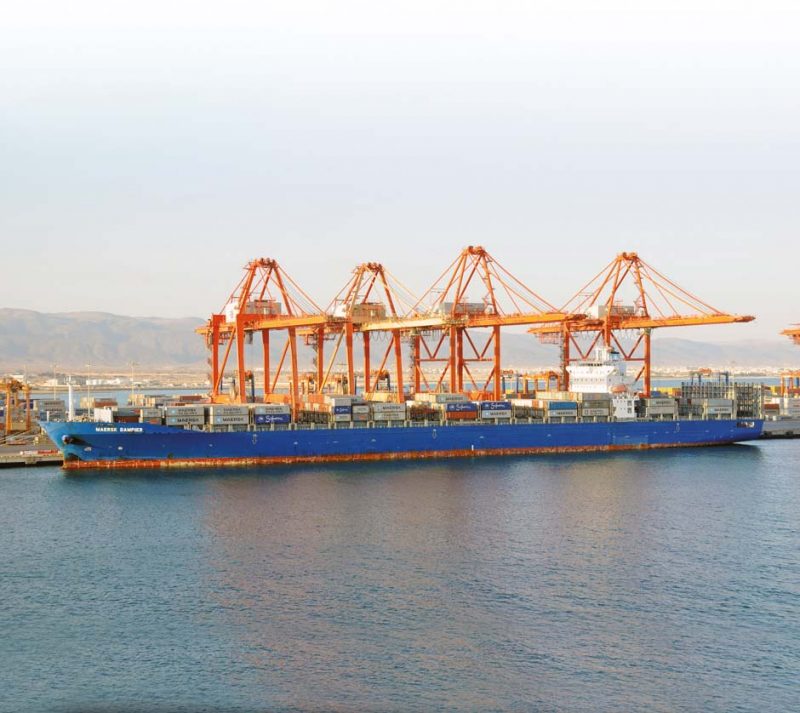
Oman Shipping Company (OSC)
The Oman Shipping Company (OSC) was set up in 2003 as a joint stock company by the Governorate of the Sultanate of Oman to develop a national fleet catering to the maritime transportation of the rapidly growing oil, petrochemical and mining industries. Oman does have large quantities of oil and gas for export, but these are handled through a deep-water terminal at Mina al Fahal. Commercial shipping operations started in 2005 with a container service begun in 2010 as the Oman Container Line (OCL) to connect the Omani ports of Salalah, Sohar and Duqm with those in the Persian Gulf. OCL currently operates a feeder service connecting Salalah, Sohar and Duqm with Jebel Ali in the United Arab Emirates (UAE) using the chartered feeder ship MCP Famagusta of 7,700 dwt, and the larger chartered container ship Hebe of 3,090 TEU capacity and built at Szczecin in Poland in 2007 as CSAV Italjai.
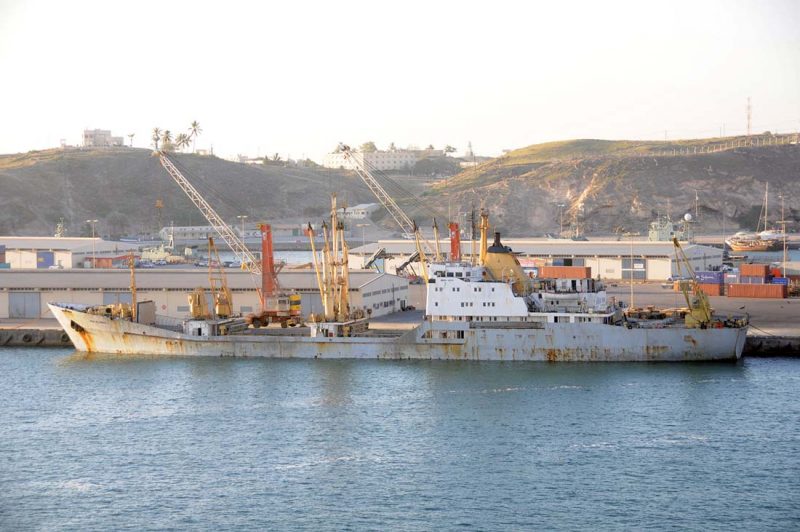
OSC is owned through the Asyad Group of Oman Global Logistics Group (79.9%), Oman Oil Company (20%) and Oman Rail (0.1%). The company undertakes a number of shipping related activities including the subsidiary companies of Oman Ship Management Company (OSMC), Oman Charter Company (OCC) and the Oman Container Line (OCL). A fleet of fifteen large LNG carriers and ore carriers is operated on worldwide trading, including Salalah LNG, Sohar LNG, Nizwa LNG, Ibri LNG, Ibra LNG, Adam LNG and Musanah of around 80,000 dwt as well as four very large ore carriers of 400,000 dwt in Liwa Max (ex Vale Liwa), Sohar Max (ex Vale Sohar), Saham Max (ex Vale Saham) and Shinas Max (ex Wafi). Two five hold geared bulk carriers of 56,300 dwt built in 2011 as Jewel of Shinas and Jewel of Sohar are also operated, the fleet having red hulls and funnel colours of red, green and white. The Oman Shipping Company is headquartered in Muscat, the capital of Oman, at Madinat Sultan Qaboos.
Container Ship Calls
The Port of Salalah is operated by the ATM Terminals subsidiary of Maersk Line as part of the APM Terminals Global Terminals Network. Maersk Line as the largest container line in the world is a major caller at Salalah, as are two more of the largest container lines in the world in Mediterranean Shipping Company (MSC), and CMA CGM, which took over American President Lines (APL) in the summer of 2016. The Government of Oman guidelines for the acceptance of cargo to and from the Port of Salalah do not include the Middle East countries of United Arab Estimates (UAE), Saudi Arabia, Bahrain, Egypt and Yemen. However, a container feeder service operates every ten days to Doha in Qatar.
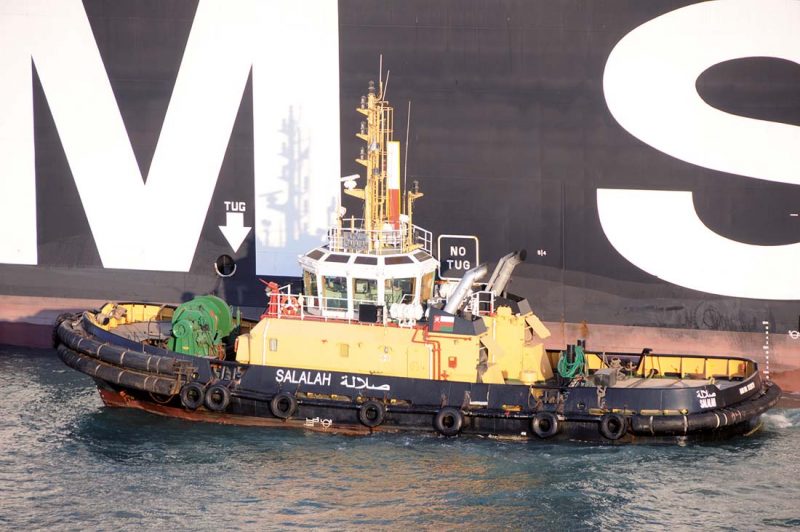
Maersk Line
The first Maersk Line ships to call at Salalah after its opening in November 1998 were eight units of the ‘L’ class built between 1981 and 1983 and lengthened in 1984 by 57.0 metres to give a deadweight of 53,450 tonnes. They were sold between 1997 and 1999 to third party operators and chartered back and renamed as Maersk Tokyo (ex Lexa Maersk), Maersk Trondheim (ex Lars Maersk), Maersk Tampa (ex Louis Maersk), Maersk Toba (ex Leda Maersk), Maersk Tacoma (ex Luna Maersk), Maersk Toyama (ex Laust Maersk), Maersk Trieste (ex Leise Maersk) and Maersk Toledo (ex Lindo Maersk). They were operating from Rotterdam and other North European ports to Salalah and ports in the Persian Gulf and the Indian subcontinent. The smaller geared feeder container vessel Maersk Victoria of 8,904 dwt with two container cranes on her port side operated a regular service from Salalah to Doha in Qatar at the same time.
The twin funnelled mega container ship Mayview Maersk called at Salalah on 10th April 2016 as a member of the ‘Triple E’ class of Maersk Line. She has a container capacity of 18,270 TEU and is measured at 194,849 grt and 194,533 dwt with a length of 399.0 metres, moulded beam of 60.0 metres and loaded draft of 11.5 metres. The ‘Triple E’ class was completed from 2014 onwards and are very regular callers at Salalah on their Europe to Far East routes and various strings of transhipment calls into the Indian subcontinent and the Persian Gulf. Maersk Kyrenia of 6,802 TEU capacity built in 2001 by Hyundai Heavy Industries, and Cornelia Maersk of 8,650 TEU capacity built in 2002 by the Odense shipyard in Denmark were callers at Salalah in September 2018.
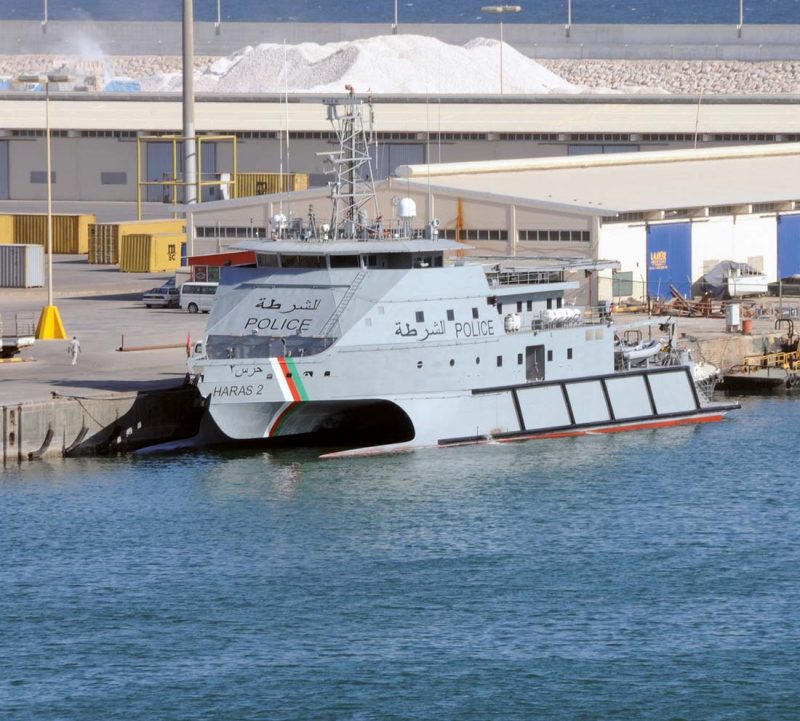
Mediterranean Shipping Company (MSC)
The mega container ship MSC London was completed in 2014 of 16,020 TEU capacity and held the previous biggest ship record of entry at Salalah. She is of 176,490 grt, 186,650 dwt with a length of 399.0 metres, moulded beam of 54.0 metres and loaded draft of 12.7 metres. She has a crew of 27 and a service speed of 25.1 knots from a powerful M.A.N. B & W diesel engine. MSC Zoe called at the port in June 2015 as the third in a series of MSC mega container ships, the first two being MSC Oscar and MSC Oliver. They have a length of 395.4 metres, moulded beam of 59.0 metres and are of 199,272 dwt with a service speed of 22.8 knots from a powerful M.A.N. B & W diesel engine of 83,800 bhp. These MSC classes of container ship held the record for the biggest ships calling at Salalah before the ‘Triple E’ class of Maersk Line.
CMA CGM
The CMA CGM Marco Polo class of 16,020 TEU capacity operate a fast Europe to China container service on the French Asia Line (FAL) services. The takeover in 2016 of American President Lines (APL) in 2016 brought the two GA1 and GA2 strings of the Gulf Asia Express (GAE) of APL into the CMA CGM entity. These operate from Shanghai, Ningbo, Taipei and Shekou to Tanjung Pelepas (Singapore), Port Klang (Malaysia), Salalah, Umm Qasr (Iraq), Jebel Ali (UAE) and return to Port Klang, Hong Kong and Shanghai. APL has been operating from Salalah since 2003, with APL Salalah completed in 2012 by Daewoo Shipbuilding and Marine Engineering of 10,700 TEU capacity including 700 reefer plugs. She is of 128,929 grt, 131,477 dwt with a length of 347.03 feet, moulded beam of 45.2 metres, and a loaded draft of 15.5 metres. She has a service speed of 24.3 knots from a powerful M.A.N. B & W diesel engine of 73,582 bhp.
APL also used the smaller class of five vessels of APL Kennedy, APL Adams, APL Jackson, APL Polk and APL Truman on the GAE services. This class of five were built in 1988 of 4,340 TEU capacity and 62,000 dwt with a length of 275.2 metres, moulded beam of 39.4 metres, and loaded draft of 12.5 metres. This class were still calling at Salalah in 2013 and originally had ‘President’ prefixes to their names, but were taken out of service in the years after 2013 and sent for scrapping.
Additional Container Lines
Hapag Lloyd big container ships call frequently at Salalah as do the newbuildings of the Japanese Ocean Network Express (ONE) founded in 2017 by NYK, Mitsui OSK Lines, and ‘K’ Line. The Chinese container lines of OOCL, CSCL and COSCO also call, as do container ships of the South Korean WEC Lines.
Other Salalah Ship Calls
Large bulk carriers of length over 200.0 metres, moulded beam of 32.0 metres and loaded draft of 7.0 metres call regularly, including Camellia Bliss of 81,600 dwt of ‘K’ Line, and Daimongate of 63,500 dwt with five holds and five hatches. The cement carrier Capri Cement of 13,180 dwt and built in 1985 as Gefion was trading to the port from Australian ports, while the tanker Al Salam II of 69,790 dwt and owned in Kuwait called at Salalah. Japanese trawlers fish in the Indian Ocean and call at the port for stores, while anchor handling tugs and offshore supply ships also call at the port in connection with the oilfields of Northern Oman and Dubai.
Royal Oman Navy
The Oman coastline has a length of over three thousand kilometres including islands with a country area of 3,100 square kilometres of which 85% is sand desert and only 15% is mountainous or coastal plain that can be exploited. The Royal Navy of Oman (RNO) has a history of fifty years, and had two corvettes completed by the Southampton yard of John I. Thorneycroft in 1985, and had a strength of three thousand personnel seven years later in 1992. Three further corvettes of up to 2,660 tonnes displacement were completed by British Aerospace Engineering (BAE) as the Khareef class of Al Shamikh, Al Rahmani and Al Rasikh during 2013 and 2014. The Royal Oman Navy currently has five corvettes, fifteen patrol and fast missile craft, and two support, training and hydrographical survey vessels.
The northern Omani oil port of Mina al Fahal and the strategic fertile plain of the Batinah and the capital of Muscat are all close to the strategically important Strait of Hormuz. Oil was first exploited in 1967 and piped across the northern mountains to Mina al Fahal in 1970, with the exchange revenues being traded in gold, which was kept in the Palace of the Sultan.
The Royal Oman Navy is thus essential to the peace of the Middle East and Persian Gulf areas, with a current strength of 4,200 personnel and a main base near As Sib at the Said ibn Sultan Naval Base located at Wudham Alwa near As Sib. This is the fleet maintenance base as well as the main operating base for officers and enlisted personnel. The Sultan Qaboos Naval Academy provides specific naval and armaments training, with training originally provided by the U.K. Royal Navy and many of its officers were originally British or Pakistani. By 1980, most of the officers were Omani although British and Pakistani technicians remained in the country.
The Royal Oman Navy does not have any naval infantry or commando troops or a Marine Corps for landings of combat troops, but does have small amphibious ships that could participate with larger navies. The U.K. Royal Navy helped train corvette crews in the Oman Flag Officer Sea Training Base in 2011, and further modernisation projects are underway for new warships in order to protect the coastline and the ‘hotspot’ of the Strait of Hormuz.
Postscript
A national Government of the Sultanate of Oman programme for enhancing economic development has scheduled the Port of Salalah container terminal to be expanded from the current 5.0 Million TEU handled per annum to 9.0 Million TEU per annum. The Sultanate of Oman is also looking for an additional investment of US$10.9 billion by 2020 to position the Port of Salalah as an even greater container transhipment hub. A new multi-purpose General Cargo Terminal for 20.0 million tonnes of dry bulks, and six million tonnes of liquid bulks came into service in 2015. This has a quay length of 1,266 metres with a width of 84.0 metres and is located on the leeward side of the southern breakwater. There are two general cargo berths each of 333.0 metres, and two liquid bulk berths each of 300.0 metres. Further investment and increased sizes of containers, dry bulks and liquid bulks tonnage handled will make the Port of Salalah a medium to large size port.





Comments
Sorry, comments are closed for this item